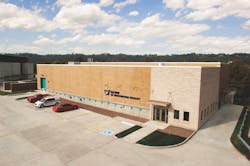Greater Cincinnati Water Works: Award-Winning Disinfection
About the author: Elisabeth Lisican is managing editor of Water & Wastes Digest. Lisican can be reached at [email protected] or 847.391.1012.
Home to two major sports teams and large events like the Flying Pig Marathon and Macy’s Music Festival, Cincinnati also houses the Richard Miller Treatment Plant (RMTP).
The Greater Cincinnati Water Works (GCWW) facility is a 240-million-gal-per-day (mgd) conventional surface water filtration plant followed by granular activated carbon (GAC) and medium pressure ultraviolet (UV) treatments. RMTP supplies water to nearly 1 million people in the Greater Cincinnati area.
“The $30 million UV facility is the largest in North America following sand and GAC processes,” said Ramesh Kashinkunti, supervising engineer for RMTP. “The 19,600-sq-ft UV facility contains eight Calgon Carbon Sentinel 48-in. Chevron UV reactors. Each reactor has five lamps and each lamp has a germicidal sensor to monitor UV intensity.”
GCWW added UV treatment to its operations because the RMTP’s Ohio River water source is affected by municipal wastewater, agricultural and storm water runoff, and other contamination sources. The UV system provides year-round disinfection for a wide range of waterborne microorganisms, including Cryptosporidium and Giardia and seasonal advanced oxidation treatment, when combined with prechlorination, for taste and odor control.
A Holistic Approach
CDM Smith provided design services for process/mechanical, architecture, electrical and instrumentation design disciplines; engineering services during construction; and startup services and testing services. Carollo Engineers was primarily responsible for the UV process design and engineering services during construction, and startup and testing services.
“The Greater Cincinnati Water Works, CDM-Smith and Carollo Engineers took a holistic, integrated approach to defining UV system’s operating strategy, meeting multiple disinfection and advanced oxidation treatment objective [while] being fully responsive to varying plant flow and water quality conditions,” Kashinkunti said. “The team also applied the U.S. Environmental Protection Agency [EPA] risk model to define UV dose requirements for new federal drinking water disinfection regulations, to evaluate costs and benefits of 2-, 3- and 4-log Cryptosporidium inactivation using UV light.”
The risk model was customized for RMTP using a Monte Carlo approach to simulate Cryptosporidium removal by the RMTP’s conventional treatment and GAC beds, and UV disinfection.
Cost Savings & Health Protection
GCWW has been operating the UV facility for almost a year and performance is as expected in terms of power costs and public health protection, with minimal off-specification water—less than 0.1%, well below the 5% limit specified by EPA requirements. Recently filed testing has indicated that the UV system is capable of applying greater than 200 mJ/cm2 doses, which is significant in terms of achieving advanced oxidation doses when coupled with prechlorination. Such a mode of operation not only will help address microbial contaminants but also emerging contaminants of concern such as pharmaceuticals and personal care products.
Excellence in Environmental Engineering & Science
In 2014, Carollo Engineers, CDM Smith and GCWW were awarded a grand prize by the American Academy of Environmental Engineers and Scientists (AAEES) for their work on the system. The AAEES Excellence in Environmental Engineering and Science Competition serves to identify and reward the best environmental engineering and science endeavors. The RMTP UV disinfection system was awarded the Grand Prize in the Operations/Management category.
“It’s a great honor to be recognized for our innovative work at the Richard Miller Treatment Plant,” said Harold Wright, chief UV Technologist for Carollo Engineers. “The entire team was focused on creating an advanced, efficient solution, while simultaneously keeping the public’s safety top of mind. At the forefront, we knew that utilizing UV treatment was critical to ensuring a successful future at RMTP.”
Download: Here
